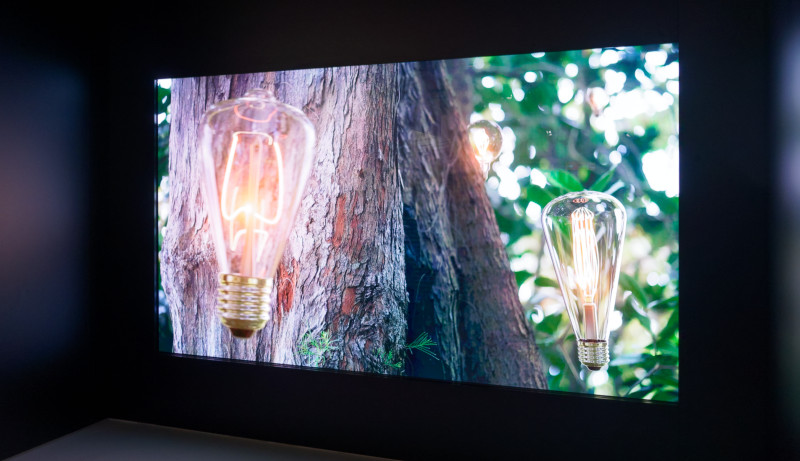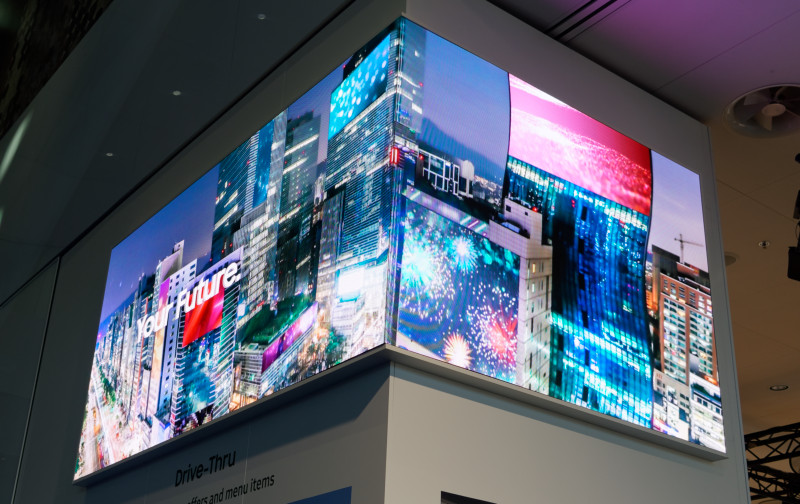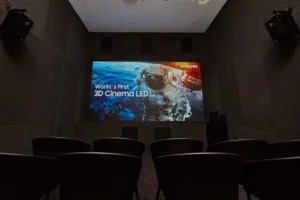We got a good chance to go around the Samsung booth at the show in its press tour. At the end, the overriding message was that looking forward, the company seems to be really going ‘all in’ on LED, with LCD hardly getting a mention as we went around the booth.
One of the main news items was the announcement of the commercial version of the 146″ Wall UltraHD LED system that Samsung plans to make available in the commercial space as well as developing it for TV. For the commercial version, peak brightness will be up to 1,600 cd/m² and the company was highlighting the flexibility of the modular approach, so it will not just be sold in the one size. Warranty will also be appropriate for commercial use. The unit also includes a controller with an SoC so that the system can support the Samsung MagicInfo software technology.
 Samsung took a lot of care to prevent viewing from the side or any reflections from the Commercial Wall display. It was in a black recess with deep sides. Image:Meko
Samsung took a lot of care to prevent viewing from the side or any reflections from the Commercial Wall display. It was in a black recess with deep sides. Image:Meko
The company was also highlighting the use of LEDs, in this case of traditional type, with 1.5mm pitch for high end boardrooms and the company told us that it is seeing demand for this kind of pitch even in retail installations where the aim is to be able to support UltraHD/4K content. On the outside of the booth, there were a number of LED displays in concave and convex configurations and staff drew our attention to the relatively small corner on an external corner. The latest IF-D series LED signage displays from the company have peak brightness up to 2,400 cd/m² peak brightness and support for HDR content.
 Samsung highlighted that the external corners of their LEDs are fine. Image:Meko
Samsung highlighted that the external corners of their LEDs are fine. Image:Meko
Cinema is Big for Samsung
Cinema is a big area for Samsung’s LED plans and to highlight this, the company set up a small LED cinema area at the event. This closed area also had the correct Harman audio with the special processing to give the impression that the audio was coming from directly behind the screen, although the speakers were above the display area. Because of the restricted space at ISE, the display was only 2K, rather than 4K, so just a quarter of the full size, but otherwise was set up to the same brightness as the commercial installations in Korea, China and Switzerland. There are still 96 x 24 modules in the 34′ diagonal display, making a total of 2304.
A change at ISE was that the 2K Cinema had been set up to allow the display of 3D using active glasses. The advantage of the LED here is very clear as the 500 cd/m² means that even though there is a lot of light loss in the glasses, the images remain bright. That is in contrast to traditional cinema displays which have low brightness after the loss of light from the 3D glasses. The standard brightness for 2D in the cinema using projection is 48 cd/m² and this is reduced by up to two thirds when viewing 3D.
Samsung’s 3D Cinema had only a few seats at the back. Note the side audio.
We got a chance to talk to a Samsung LED Cinema specialist who told us that it is working with Hollywood to develop a 2K cinema display, like the one in Amsterdam, to be used for grading. We also had a discussion about black levels. Of course, turning off the pixel is the same as complete black, but we found that the lowest level of dark grey, just one unit above black, produces 0.05 cd/m² of output.
We also heard that Samsung is looking to get approval for its 2K LED cinema display from DCI, which may be approved by May this year, and is also developing an 8K version. However, Samsung has been somewhat frustrated by the way that DCI works. A huge amount of work went into developing the DCI standard, so the group is extremely reluctant to change the core of it. It is prepared to supplement the specification to meet the requirements of LED, but that causes some problems.
For example, DCI mandates that the Cinema LED display has to be maintained from the back, rather than from the front, for security reasons. This seems very limiting to Samsung as it is not feasible to try to unpick pixel values from the front of the display by intercepting the drive electronics. As staff said to us, somebody trying to tap into the front of the Cinema LED would be very obvious to cinema staff, very quickly.
One of the developments shown at ISE was an improvement in audio that is directed towards the display and bounces off the front of the LEDs to help to create the impression that audio is coming directly from the display surface. More work is also being done on the algorithms for ‘lowering’ the audio which tend to reduce the high frequency components. The bouncing of the audio is intended to partly offset this effect.
Bidirectional Communication is Important for Flip
The Samsung Flip display was one of the new products that was shown at CES and it was highlighted at ISE. In discussions, we heard that one of the features that was shown at CES is believed by Samsung to be unique and that is the bi-directional annotation function. When the Flip is used with a handheld device, not only do annotations on the handheld appear on the main display, but annotations made on the Flip are mirrored back to the handheld. Staff told us that the solutions from other providers usually support one or the other, but not both.
Samsung also had its latest QM series (450 cd/m² of output) and QB series (350 cd/m² of output) which use UltraHD panels and have integrated upscaling processors to optimise the look of FullHD content, which still dominates the signage market. The displays have new centralised infrared receivers for remote control and management and the SoC-based displays are certified to IP 5x for exposure to dirt and dust.
Analyst Comment
I thought that much of the 3D demo was impressive, but I did see some artefacts when there was fast motion. In the short demo and without more control over the content, it is hard to know whether this was just an issue with the 24fps content or whether it related to the active solution – I tend to see the same issues when I go to watch 3D in the cinema and that is usually passive. However, in discussion with Samsung’s specialist, I heard that Hollywood studios are absolutely insisting that if they plan to do grading in 3D, they will not accept active and Samsung will need to develop a passive solution. We had an interesting conversation, based on the tests done by Ray Sonera with LG’s passive TVs, about whether the use of passive displays actually reduces the resolution of the human visual system by half!
(BR)

